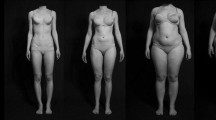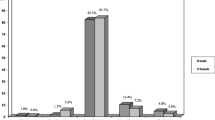Abstract
Little is known about body images of siblings of patients with eating disorders. In this study we investigated body images of patients with anorexia or bulimia nervosa and of the patients’ brothers and sisters. A computer program was employed that allows modeling perceived and desired body images of patients and family members. Patients, siblings and male and female control subjects rated their body images. The selected images were compared with anthropometric data. All subjects also filled out a body image questionnaire. Data from 30 patients, 38 siblings, and 60 control subjects are presented. Siblings did not differ from healthy control subjects. Self-ideal discrepancy was different in patients with anorexia and their sisters. Body image was more negative in patients than in their sisters. Siblings of patients with eating disorders seem to be rather unimpaired in terms of body image disturbances.


Similar content being viewed by others
References
Agras S, Hammer L, McNicholas F (1999) A prospective study of the influence of eating-disordered mothers on their children. Int J Eat Disord 25:253–262
Baghurst T, Hollander DB, Nardella B, Haff GG (2006) Change in sociocultural ideal male physique: an examination of past and present action figures. Body Image 3:87–91
Benninghoven D, Jürgens E, Mohr A, Heberlein I, Kunzendorf S, Jantschek G (2006) Different changes of body-images in patients with anorexia or bulimia nervosa during inpatient psychosomatic treatment. Eur Eat Disord Rev 14:88–96
Benninghoven D, Tetsch N, Kunzendorf S, Jantschek G (2007) Body image in patients with eating disorders and their mothers, and the role of family functioning. Compr Psychiatry 48:118–123
Benninghoven D, Tetsch N, Kunzendorf S, Jantschek G (2007) Perceptual body image of patients with anorexia or bulimia nervosa and their fathers. Eat Weight Disord 12:12–19
Bönsch C, Raml E, Seiwald M, Rathner G (1993) Das Körpererleben magersüchtiger Mädchen, ihrer Mütter und Schwestern: Eine kontrollierte Studie (Body image of anorexic girls, their mothers and sisters: a controlled study). Psychother Psychosom Med Psychol 43:420–427
Bulik CM, Sullivan PF, Wade TD, Kendler KS (2000) Twin studies of eating disorders: a review. Int J Eat Disord 27:1–20
Cafri G, Roehrig M, Thompson JK (2004) Reliability assessment of the somatomorphic matrix. Int J Eat Disord 35:597–600
Cafri G, Straus J, Thompson JK (2002) Male body image: satisfaction and its relationship to well-being using the somatomorphic matrix. Int J Men’s Health 1:215–231
Cash TF, Deagle EA (1997) The nature and extent of body-image disturbances in anorexia nervosa and bulimia nervosa: a meta-analysis. Int J Eat Disord 22:107–125
Casper RC (1990) Personality features of women with good outcome from restricting anorexia nervosa. Psychosom Med 52:156–170
Clement U, Löwe B (1996) Fragebogen zum Körperbild. Hogrefe, Göttingen
Clement U, Löwe B (1996) Die Validierung des FKB-20 als Instrument zur Erfassung von Korperbildstorungen bei psychosomatischen Patienten (Validation of the FKB-20 as a scale for the detection of body image distortions in psychosomatic patients). Psychother Psychosom Med Psychol 46:254–259
Farell C, Lee M, Shafran R (2005) Assessment of body size estimation: a review. Eur Eat Disord Rev 12:75–88
First MB, Spitzer RL, Gibbon M, Williams JBW (2002) Structured clinical interview for DSM-IV-TR axis I disorders, research version, non-patient edition (SCID-I/NP). Biometrics Research, New York State Psychiatric Institute, New York
Frederick DA, Fessler DMI, Haselton MG (2005) Do representations of male muscularity differ in men’s and womens’ magazines? Body Image 2:81–86
Fydrich T, Renneberg B, Schmitz B, Wittchen HU (1997) Strukturiertes klinisches Interview für DSM-IV Achse II: Persönlichkeitsstörungen. Hogrefe, Göttingen
Garner DM (2002) Body image and anorexia nervosa. In: Cash TF, Pruzinsky T (eds) Body image: a handbook of theory, research, and clinical practice. Guilford, New York, pp 295–303
Gruber AJ, Pope HG, Borowiecki JJ, Cohane G (2000) The development of the somatomorphic matrix: a bi-axial instrument for measuring body image in men and women. In: Norton K, Olds T, Kollman J (eds) Kinanthropometry VI. International Society for the Advancement of Kinanthropometry, Adelaide, pp 217–231
Gruber AJ, Pope HG, Lalonde JK, Hudson JI (2001) Why do young women diet? The roles of body fat, body perception, and body ideal. J Clin Psychiatry 62:609–611
Hargreaves DA, Tiggemann M (2004) Idealized media images and adolescent body image: comparing boys and girls. Body Image 1:351–361
Hausmann A, Mangweth B, Walch T, Rupp CI, Pope HG (2004) Body image dissatisfaction in gay versus heterosexual men: is there really a difference? J Clin Psychiatry 65:1555–1558
Hennighausen K, Enkelmann D, Wewetzer C, Remschmidt H (2003). Body image distortion in anorexia nervosa—is there really a perceptual deficit? Eur Child Adolesc Psychiatry 8:200–206
Karwautz A, Nobis G, Haidvogl M, Wagner G, Hafferl-Gattermayer A, Wober-Bingol C, Friedrich MH (2003) Receptions of family relationships in adolescents with anorexia nervosa and their unaffected sisters. Eur Child Adolesc Psychiatry 12:128–135
Klump KL, Wonderlich S, Lehoux P, Lilenfeld LRR, Bulik CM (2002) Does environment matter? A review of nonshared environment and eating disorders. Int J Eat Disord 31:118–135
Kouri E, Pope HG, Katz DL, Olivia P (1995) Fat free mass index in users and nonusers of anabolic-androgenic steroids. Clin J Sport Med 5:223–228
Leit RA, Gray JJ, Pope HG (2002) The media’s representation of the edial male body: a cause of muscle dysmorphia? Int J Eat Disord 31:334–338
Leit RA, Pope HG, Gray JJ (2001) Cultural expectations of muscularity in men: the evolution of playgirl centerfolds. Int J Eat Disord 29:90–93
Lintsi M, Kaarma H, Kull I (2004) Comparison of hand-to-hand bioimpedance and anthropometry equations versus dual-energy X-ray absorptiometry for the assessment of body fat percentage in 17–18-year-old conscripts. Clin Physiol Funct Imaging 24:85–90
Lipinski J, Pope HG (2002) Body ideal in young samoan men: a comparison with men in North America and Europe. Int J Men’s Health 1:163–171
Maloney MJ, Shepard-Spiro P (1983) Eating attitudes and behaviors of anorexia nervosa patients and their sisters. Gen Hosp Psychiatry 5:285–288
Mangweth B, Hausmann A, Walch T, Hotter A, Rupp CI, Biebl W, Hudson JI, Pope HG Jr (2004) Body fat perception in eating-disordered men. Int J Eat Disord 35:102–108
Murphy F, Troop NA, Treasure JL (2000) Differential environmental factors in anorexia nervosa: a sibling pair study. Br J Clin Psychol 39:193–203
Olivardia R, Pope HG, Borowiecki JJ, Cohane GH (2004) Biceps and body image: the relationship between muscularity and self-esteem, depression, and eating disorder symptoms. Psychol Men Masculinity 5:112–120
Penner LA, Thompson JK, Coovert DL (1991) Size overestimation among anorexics: much ado about very little? J Abnorm Psychol 100:90–93
Piccoli A, Codognotto M, Di Pascoli L, Boffo G, Caregaro L (2005) Body mass index and agreement between bioimpedance and anthropometry estimates of body compartments in anorexia nervosa. J Parenter Enteral Nutr 29:148–156
Pope HG, Gruber A, Mangweth B, Bureau B, De Col C, Jouvent R, Hudson JI (2000) Body image perception among men in three countries. Am J Psychiatry 157:1297–1301
Pope HG, Olivardia R, Gruber A, Borowiecki J (1999) Evolving ideals of male body image as seen through action toys. Int J Eat Disord 26:65–72
Probst M, Vandereycken W, van Coppenolle H (1997) Body size estimation in eating disorders using video distortion on an life-size screen. Psychother Psychosom 66:87–91
Scalfi L, Marra M, Caldara A, Silvestri E, Contaldo F (1999) Changes in bioimpedance analysis after stable refeeding of undernourished anorexic patients. Int J Obes Relat Metab Disord 23:133–137
Skrzypek S, Wehmeier PM, Remschmidt H (2001) Body image assessment using body size estimation in recent studies on anorexia nervosa. A brief review. Eur Child Adolesc Psychiatry 10:215–221
Stein D, Lilienfeld LR, Piotnicov K, Pollice C, Rao R, Strober M, Kaye WH (1999) Familial aggregation of eating disorders: results from a controlled family study of bulimia nervosa. Int J Eat Disord 26:211–215
Stice E (2002) Risk and maintenance factors for eating pathology: a meta-analytic review. Psychol Bull 128:825–848
Stice E, Shaw HE (2002) Role of body dissatisfaction in the onset and maintenance of eating pathology: a synthesis of research findings. J Psychosom Res 53:985–993
Strober M, Freeman R, Lampert C, Diamond J, Kaye W (2000) Controlled family study of anorexia nervosa and bulimia nervosa: evidence of shared liability and transmission of partial syndromes. Am J Psychiatry 157:393–401
Strober M, Morrell W, Burroughs J, Salkin B, Jacobs C (1985) A controlled family study of anorexia nervosa. J Psychiatr Res 19:239–246
Theander S (1970) Anorexia nervosa: a psychiatric investigation of 94 female cases. Acta Psychiatr Scand Suppl 241:1–194
Tovée MJ, Benson PJ, Emery JL, Mason SM, Cohen-Tovée M (2003) Measurement of body size and shape perception in eating-disordered and control observers using body-shape software. Br J Psychol 94:501–516
Tsiantas G, King RM (2001) Similarities in body image in sisters: the role of sociocultural internalization and social comparison. Eat Disord J Treat Prev 9:141–158
Vandereycken W, Van Vreckem E (1992) Siblings of patients with an eating disorder. Int J Eat Disord 12:273–280
Wade TD, Treloar SA, Martin NG (2001) A comparison of family functioning, temperament, and childhood conditions in monozygotic twin pairs discordant for lifetime bulimia nervosa. Am J Psychiatry 158:1155–1157
Wittchen HU, Zaudig M, Fydrich T (1997) Strukturiertes Klinisches Interview für DSM-IV. Göttingen, Hofrefe
Wunderlich U, Gerlinghoff M, Backmund H (2004) Eating disturbances in siblings of patients with eating disorders. Eat Weight Disord 9:258–263
Yang CF, Gray P, Pope HG (2005) Male body image in Taiwan versus the West: Yanggang Zhiqi meets the Adonis complex. Am J Psychiatry 62:263–269
Acknowledgments
We are indebted to Andreas Mohr, Sabine Pfaudler, Lena Raykowski, Beate Schmidt, and Vera Tadic for their contribution to this study.
Author information
Authors and Affiliations
Corresponding author
Rights and permissions
About this article
Cite this article
Benninghoven, D., Tetsch, N. & Jantschek, G. Patients with eating disorders and their siblings. Eur Child Adolesc Psychiatry 17, 118–126 (2008). https://doi.org/10.1007/s00787-007-0645-9
Accepted:
Published:
Issue Date:
DOI: https://doi.org/10.1007/s00787-007-0645-9




